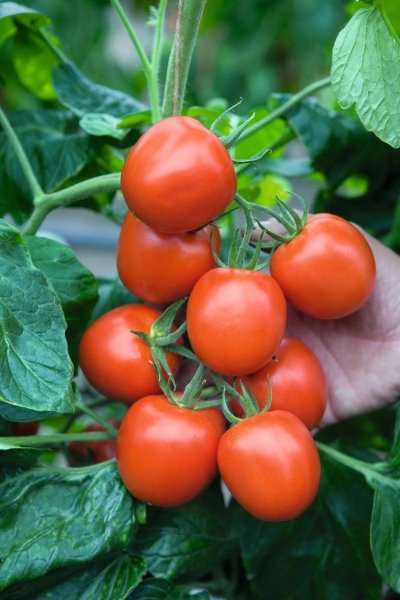
- Authors: Holland
- Year of approval: 2009
- Category: hybrid
- Growth type: determinant
- Appointment: fresh consumption, for whole fruit preservation
- Ripening period: mid-early
- Ripening time, days: 100-105
- Growing conditions: for open ground, for film greenhouses
- Leaves: medium, green
- Unripe fruit color: light green
Richie's tomato is a Dutch bred hybrid, approved for use in Russia in 2009. Suitable for planting in open ground and greenhouse cultivation, not intended for commercial purposes.
Description of the variety
The bushes develop according to the determinant type, are of medium size, covered with medium-sized green leaves. The average height of the stems is 70 cm. The foliage is good. It is formed according to the standard type, the growth of the bush is limited after the appearance of 5 flower clusters.
The main qualities of the fruit
Tomatoes have a nice round shape. They are medium in size, reaching a mass of 120 g. The skin is smooth, at first it has a light green color, then it turns red. Medium density pulp, not prone to excessive juicing.
Taste characteristics
Assessment of the palatability of the fruit is high. They contain quite a lot of sugars, are suitable for fresh consumption, canning with whole fruits.
Ripening and fruiting
The hybrid belongs to the mid-early category. You can start harvesting fruits in 100-105 days.
Yield
The collection volumes reach 7.9 q / q. m.
The timing of planting seedlings and planting in the ground
In February-March, sowing of seeds for seedlings begins. The exact dates are determined by the further cultivation method. Transfer to the greenhouse is possible already in April-May. Tomatoes are planted in open ground in June, when return frosts take place.

Growing tomato seedlings is an extremely important process, because it largely depends on whether the gardener will be able to harvest at all. All aspects must be taken into account, from seedbed preparation to planting in the ground.
Landing scheme
It is best to arrange plants according to a 40 × 50 cm pattern. Up to 6 plants can be placed per 1 m2.

Growing and care
In the process of growing, the bushes require partial pinching, a garter to the support. The hybrid is sensitive to growing conditions. He needs moderately moist soil, light shading - it is not recommended to plant plants in open places. When pinching, 3 side shoots are left to ensure full ripening of the fruits. Throughout the growing period, Richie requires compound fertilization.
The preferred soil composition for these tomatoes is neutral. On alkaline soils, a slight acidification of the composition is recommended, otherwise the bushes develop worse. The formation of the bush is carried out in 3-4 stems, with balcony growing - in 2.




A plant needs different micronutrients at each stage of growth. All fertilizers can be divided into two groups: mineral and organic. Folk remedies are often used: iodine, yeast, bird droppings, eggshells.
It is important to observe the rate and period of feeding. This also applies to folk remedies and organic fertilizers.
Disease and pest resistance
The hybrid is highly resistant to verticillium. Rarely affected by Fusarium. Richie tomatoes in general have strong immunity, practically do not suffer from common diseases, including TMV, leaf spot. Insect pests require preventive treatment during the summer months. If signs of root rot are detected, it is necessary to reduce the amount of watering, intensify loosening, and mulch the soil surface.


Resistant to adverse weather conditions
In the open field, the tomatoes of this hybrid are sensitive to intense sunlight. Needs shading. Otherwise, it is stress-resistant, tolerates transplantation and changes in climatic conditions well.
Growing regions
The hybrid is successfully grown practically throughout the entire territory of the Russian Federation. There is experience of its cultivation in Eastern and Western Siberia, in the Far East. In the Moscow region and the Leningrad region, in the middle lane, cultivation in a shelter is recommended. In the North Caucasus, in the Central Black Earth Region, planting directly into the ground is possible, without the use of greenhouses.
Review overview
Richie's hybrid, according to amateur vegetable growers, has good commercial prospects, since the fruits are calibrated, with a good yield of marketable tomatoes. They tolerate transportation well. It is noted that during the season tomatoes do not get sick, demonstrate an active and friendly set of deciduous mass, and tie well. In use, the fruits are universal, they are good both fresh and in processing. The hybrid is also praised for the fact that the harvest is early ripening, you can plant plants even in regions with a short summer.
The disadvantages of summer residents include the impossibility of obtaining seed for subsequent independent reproduction. Not all summer residents are satisfied with the fertility indicators of the bushes.Abundant yields are obtained only where the plantings are densely enough. In addition, the hybrid is quite picky about care. He has to pay a lot of attention.

























































































